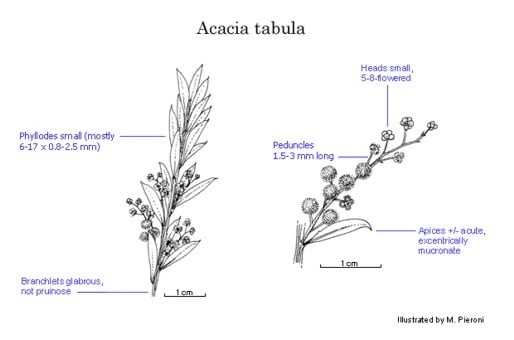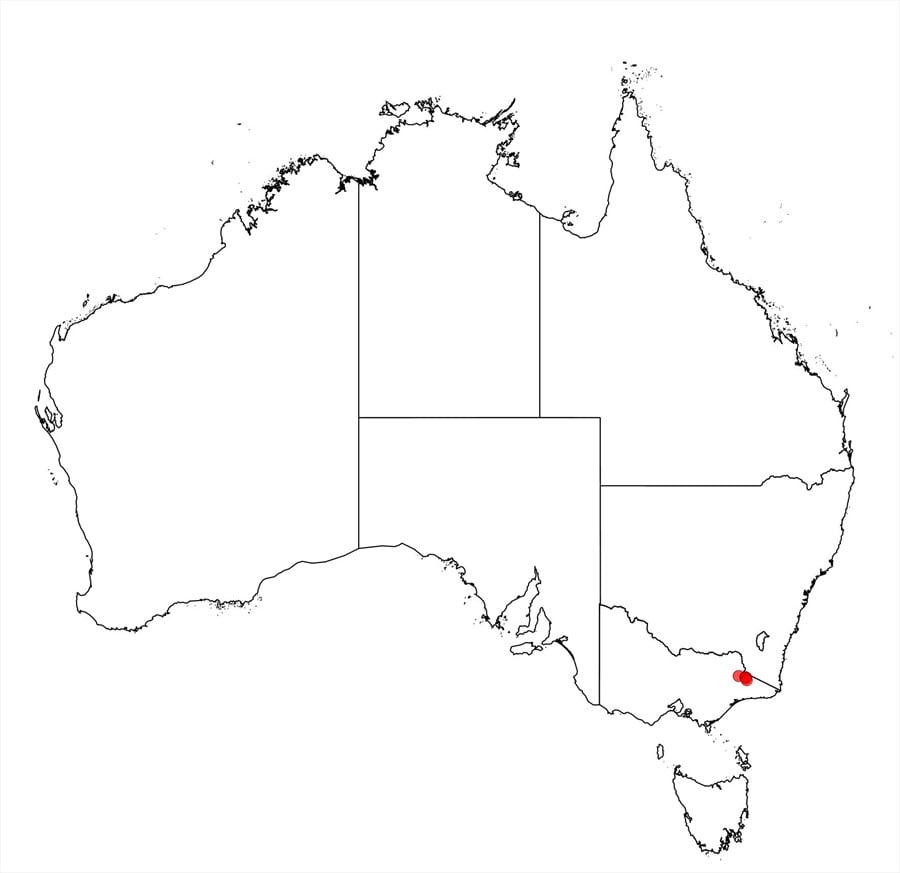Acacia tabula Molyneux & Forrester
WATTLE
Acacias of Australia
Common Name
Wombargo Wattle
Family
Fabaceae
Distribution
Known only from type locality, Splitters Ck, S of Wulgulmerang in East Gippsland, Vic. Currently known from a single small population on the Wombargo Ra. in the upper catchment of Little R., a tributary of the Snowy R. The population comprises small fragmented stands in close proximity extending across a slope overlooking and S of Splitters Ck.
Description
Erect shrub 0.25–0.5 m high, readily suckering. Branchlets not pruinose, glabrous. Phyllodes inaequilaterally narrowly oblong-elliptic, 6–17 mm long, 0.8–2.5 (–4.2) mm wide, acute to sub-acute, excentrically mucronate, thin-textured, grey-green, glabrous; midrib not prominent, lateral nerves obscure or absent; gland 1.5–4.5 (–6.5) mm above pulvinus. Inflorescences (5–) 8–10-headed racemes; raceme axes (5–) 8–10 (–12) mm long; peduncles 1.5–3 mm long, glabrous; heads globular, 3–4 mm diam. (dry), 5–8-flowered, golden. Flowers 5-merous; sepals united. Pods and seeds not seen.
Phenology
Flowers late Aug.–early Oct.
Habitat
Grows in dry woodland and heathland on high rocky ground in shallow soils derived from sediments.
Specimens
Vic.: Splitters Ck above Limestone Creek Rd, 30 Apr. 1986, W.M.Molyneux & S.G.Forrester s.n. (MEL 1545133;); Splitters Ck, c. 10 km SW of Suggan Buggan, 9 Sep. 1962, K.C.Rogers (MEL 600258).
Notes
Most closely related to A. buxifolia subsp. buxifolia which differs in its taller stature, generally larger phyllodes that often lack a gland and larger heads, see W.M.Molyneux & S.G. Forrester (Muelleria 26(1): 54, Table 1 (2008)) for a detailed comparison of these two species.
A slow-growing dwarf species that spreads by suckering; it was treated as a dwarf variant of A. buxifolia subsp. buxifolia by B.R.Maslin in Fl. Australia 11A: 341 (2001). Acacia nanopravissima and A. infecunda occur in the same area and were treated as dwarf variants of A. pravissima and A. boormanii in Fl. Australia 11A: 331 & 334 (2001) respectively.
FOA Reference
Flora of Australia Project
Author
B.R.Maslin
This identification key and fact sheets are available as a mobile application:
URL: https://apps.lucidcentral.org/wattle/
© Copyright 2018. All rights reserved.







